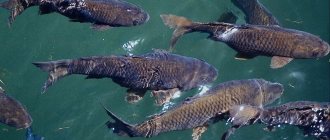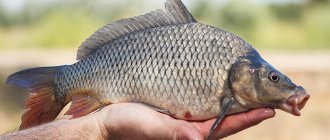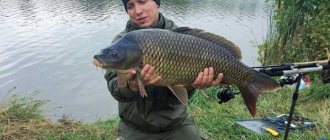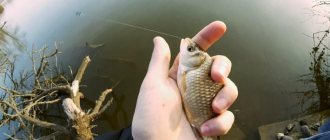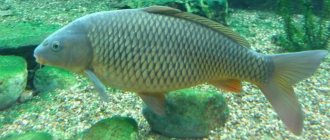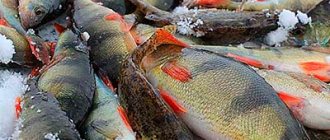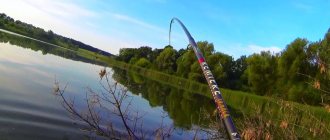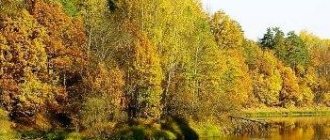Spring is a good time for carp fishermen - carp begin to show their activity. In the southern regions, carp fishing begins in early spring - in March; in the northern regions, fishing begins in April and May. Fishing takes place using carp rigs, a feeder using boilies, corn and other baits, and float gear. Carp are mainly caught in ponds and standing reservoirs. In this article you will learn everything about spring carp fishing, you will be able to choose baits, bait, equipment, and also watch a video on carp fishing in early spring.
When does carp start biting in the spring?
Depending on the region - the further south the region, the higher the temperature in early spring, the earlier the carp begins to bite.
The optimal temperature for the start of carp activity is considered to be 12-14 degrees Celsius.
Early spring – March and April
By the end of March, carp begin to become active, 2-3 weeks after the ice melts.
It is easiest to find on ponds; it is less common on rivers with minimal flow. In early spring, carp are active in the following regions:
- Krasnodar region;
- Rostov region;
- Stavropol region;
- Kalmykia;
- Astrakhan region.
Ukraine:
- Kherson region;
- Nikolaevkskaya area.
In April, carp begin to bite in the following areas:
- Voronezh region;
- Saratov region;
- And other regions of central Russia.
In May
Carp fishing starts everywhere in May. The reservoirs are sufficiently warmed up and the carp (like the carp) is becoming more and more active, starting to leave their wintering pits and strive for warm areas of ponds and other bodies of water. In the same Rostov region, carp fishing is already in full swing in May, just like in the Lipetsk or Saratov regions.
However, in some northern parts of Russia, carp begin to bite only towards the end of June.
The problem with catching carp in the spring is frequent changes in pressure , and carp, like many other fish, does not like this. Ideally , if the weather is the same for 3-4 days in a row, with a minimal difference in temperature.
Bait and bait for March carp fishing
Despite the fact that spring has arrived, in March carp prefer “winter” bait options: bloodworms, maggots and worms. Particular attention should be paid to the dragonfly larva, it can give good results. Those who like to experiment can try catching this fish with vegetable baits: corn, green peas, and boilies.
As for the bait mixture, it is not difficult to purchase bait in a store, where the sales assistant will offer you ready-made “treats” for the underwater inhabitant. There is another option - make your own bait. To do this you will need cake, feed bloodworms and soil directly from the fishing spot. All these components are mixed in a container, and water (also from a reservoir) is added to the finished mixture until the consistency reaches medium viscosity. Important: the bait should begin its “decay” directly at the bottom, and not in the water column.
Where to look for carp in spring
After winter, in early spring, carp begin to look for places with the warmest water - shallow waters. Working depth is about 3 meters. In other cases, carp can swim near the surface, no more than 1 meter deep. If the sun's rays have been touching the reservoir for several days, then the carp will most likely swim to such places.
Favorite places for carp in spring:
- Trees over water.
- Snags and fallen trees.
- Aquatic vegetation (thickets, reeds, cattails, dense algae, water lilies).
- Any obstacles in which you can hide.
- Island areas.
In addition to all the conditions, carp loves :
- Areas of a body of water where the water is warmer than in other areas
- So that the water is rich in oxygen.
- Muddy bottom.
From this it follows that it is not at all necessary to use a feeder or boilie rig with long casts, heavily enclosing it; in the spring, the carp does not hesitate to swim to the shore, in shallow water, where the depth is no more than 3 meters.
Bait
In spring, carp are not as fussy as the rest of the time, so you can use a lot of things as bait. At the beginning of spring, bait of animal origin will be preferable for use on float tackle:
- Dung or earthworm.
- Maggot.
- Various mollusks and crustaceans.
- Insects.
It is worth remembering the advice when catching any fish and using what is found in the reservoir - such a cunning fish as carp will more readily prefer local food to overseas baits.
Towards the end of spring, when there is a large abundance of plant and animal food in the reservoir, you can experiment with different attachments. Suitable for this:
- Canned corn.
- Potato.
- Steamed peas.
- Bread.
- Boilies with meat flavor.
- Foam balls.
The technique of fishing with float tackle does not differ from the usual one, with some exceptions. Namely, it is necessary to make a large draft (loading) of the float. Only the top of the float should remain above the water. This is due to the feeding habits of carp, which collect food from the bottom.
In the case of fishing with donks (feeder, elastic band, spring, etc.), various doughs and porridges are used. The following complementary food works well: 2 parts cookies, 1 part cake, 2 parts corn, 1 part wheat and 1 part bran. All this is crushed, mixed, water is added and the resulting mass is stuffed into feeders. The dough should be viscous, not washed out or crumble. You can also use ready-made bait from the store.
The donk fishing technique does not have any special features. After assembling the gear and filling the feeder with bait, a cast is made to the intended habitat of the fish, after which the line is pulled up so that it is almost taut. In this case, the rod should form a single line with the stretched fishing line. After which the bite alarm is attached. It’s hard to miss a carp bite – it’s a strong fish and it bites confidently.
Lures and Lures
The range of lures and lures for carp is quite extensive, but well-established. Each is used based on the specific body of water and the preferences of each angler.
Boyles
Boilies are a popular bait for catching carp species - ide, bream, carp, carp, etc. They are balls from 6 mm to 30 mm.
Made from food products (starch, cake, cereals, corn and other types of flour, etc. Each manufacturer has its own recipe and composition), using preservatives and flavoring additives. Boilies are used in combination with hair equipment .
What types are there?
| Dusty (soluble) | They dissolve in water, creating a cloud of turbidity, attracting carp. |
| Boiled (insoluble) | They retain their shape while remaining on the bottom. |
| Drowning | They sink to the bottom without additional loading, on their own. |
| Floating (Pop up) | Free (or controlled) swimmers, some species float to the surface. |
If you are already familiar with the introductory information , we have a separate article on catching carp with boilies , as well as their preparation.

Types of boilie colors

Homemade boilie on a hair rig
Which ones are best for carp in the spring?
For medium-sized carp from 1.8 kg boilies of 10-14 mm are suitable, for large specimens boilies up to 20 mm are suitable. There is no difference in color, but there is a difference in taste. In spring, sweetish flavors are best for carp , for example:
- Vanilla;
- Honey;
- Berry (raspberry, etc.);
- Shrimp flavored.
The rest, for example with the taste of worm or makukha, are better suited in summer and autumn.
Secret! Before throwing the boilie, dip it in anise oil, which carp loves so much. This will be more likely to attract him.
When casting long distances, rigging with boilies on a weighted hair rig, casting, as with a feeder, occurs above the head.
Corn, peas and other grains
Grain equipment is used more often in late spring, starting in May. The main ones are, of course, corn and peas , but a variety of grains are used, for example barley, and sometimes even sesame and beans.
Corn is and is used:
- Boiled. Easy to prepare, apart from removing the grains from the head. Cooking time – 3.5 hours. Pre-soaking reduces cooking time.
- Canned. Any purchased one. The most accessible type of corn.
- Fermented (drunk, fermented). The most “fragrant” type of corn. Corn ferments with yeast for several days in its own juice, after which corn with a characteristic smell is obtained. In details .
- Silicone. The advantage of such corn is buoyancy ( pop-up ). The downside is the lack of any flavoring.
Of the types presented, we recommend using canned and fermented corn. It is the fragrant bait that the carp finds faster, “vacuuming” the bottom with its mouth.
Peas are used:
- Canned . It often fits poorly due to flabbyness.
- Boiled . Medium-cooked peas are good for carp fishing.
- Silicone . Recently, this option has appeared after corn. But it often doesn't even look like a pea.
Peas can be used in combination with corn, where a large hook can accommodate several kernels.
Other grains are of questionable effectiveness, but this does not mean that they cannot be used.
Live baits
Mostly worms are used, but maggots are also used. These baits are used mainly in the fall, but can also be used in the spring if there is no bite.
Often the worm is placed in addition to corn or boilie, that is, it is not used as an independent bait.
Spring bait.
Feeder fishing is, first of all, about the right fishing spot and the right bait. If in the summer, and even in the current, almost any bait mixtures with the addition of millet, boiled corn, peas for fishing, pearl barley work, then the bait for winter and spring is somewhat different.
Fish in still cool water are inactive and fill up quite quickly. Do not forget that as spawning approaches (May-June), caviar and milt take up more and more space in the carp’s belly, and the amount of food consumed decreases.
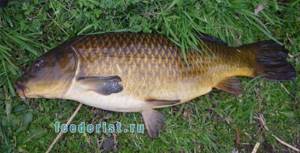
When fishing on a river, especially on a strong spring current, the issue of nutritional value of bait is not as acute as when fishing on a lake. But you need to remember this. If we add porridge to the bait, then we do it sparingly. If in summer such an additive can amount to up to 50% of the volume of the feeder, then in the spring we fill a quarter of the feeder, and some casts are generally made with one bait.
Fishing for carp in the spring requires less nutritional bait and the mandatory addition of animal components .
Bloodworms, mothballs and chopped worms are used as such components. Half of the feeder is filled with bait, then, for example, maggot is added to the middle, and the rest is filled with bait again.
Snaps
There are bottom and feeder equipment for fishing at great depths, as well as hair equipment, which can be used at shallow depths.
Hair rig
Hair rigs are effectively used when fishing with boilies and corn.
The advantage of such equipment is that the carp will 100% capture the hook and the chance of getting lost is minimized.
How to knit a hair snap?
- The cord is threaded through the hook
- A figure eight knot is knitted on the back of the leash (we recommend looper). Trim off the excess.
- A stopper is inserted into the loop.
- The corn or boilie is pierced in the center, the fishing line is threaded through the nozzle, right up to the stopper
- Pull up
- We measure the length of the hair, the boilie should be close to the hook (the boilie is 4-6 mm from the top of the hook)
- We wind on the hook, 8-12 turns.
- We thread the line through the eye again. Let's pull it up.
- On the back side of the fishing line we knit a knot that will connect this equipment to the main fishing line.
- Ready! If desired, you can add a sinker shot to secure the elements, cambrics for connections and tubes to protect them.
Video - how to make a hair rig step by step:
This equipment is used both in still water and in weak currents.
Feeder – flat method
The flat method is a special feeder on which bait is attached. It is considered the bottom article.
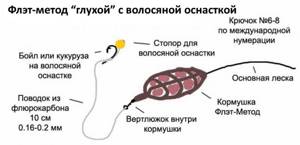
advantages of the flat fishing method:
- Feeding a place using a feeder
- Open feeder, food is quickly distributed along the bottom even in still water
- The gear is easily upgraded to suit the conditions: it’s easy to add a sinker for fishing in the current
- The weight of the feeder is usually about 30-40 grams.
A fishing line with a feeder is attached to the main line (by a loop-to-loop connection or a swivel), and a hairline comes from the feeder itself. Hair accessories can also be attached to the cord, but this increases the chance of overlap.
- Hooks are taken in 4, 6, 8 , depending on the size of the expected carp.
- The leash is usually made from 0.25 mm cord due to stretchability, but recently fluorocarbon up to 0.2 mm .
- The length of the hair leash is no more than 15 centimeters .
Fishing with paternoster
A more classic feeder tackle. Used when fishing in currents. A paternoster is always a closed feeder in the form of a cage. The bite sensitivity is slightly less than that of the flat. Existing types of feeder paternoster:
- Sliding . Used in competitions, the leash slides between two stoppers.
- Deaf . He's classic.
- Gardner's paternoster . Well suited for fishing on muddy bottoms.
- With twist . Reduces the chances of overlap. Good for carp fishing on snags.
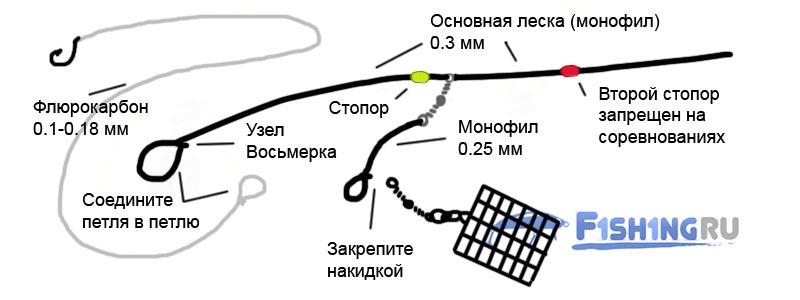
Spring
The spring is another popular equipment, used for both carp and crucian carp. For crucian carp there is even a special name for it - “crucian carp killer” .
The principle of operation is similar to a flat - such a feeder with bait is considered open. The difference is in the number of hooks and attachments on them. Such equipment is easy to manufacture and there are countless variations. However, such tackle is not considered sports, and is often prohibited, especially in the spring, primarily due to the number of hooks per tackle.
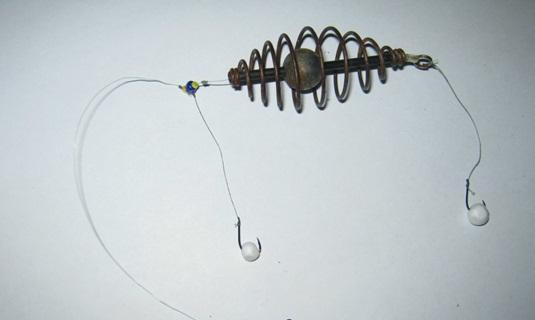
Option #1
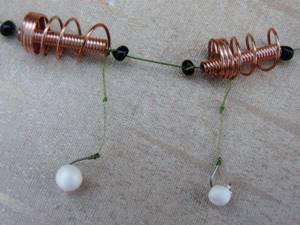
Option No. 2 Option for rigging a spring with the wrong hair
Fishing for carp in spring - video
Fishing with a float rod :
Carp fishing in cold water in early spring:
Fishing tricks
Those who have been “hunting” for carp for a long time know firsthand that this fish is very neat. Throughout the entire fishing process, the fisherman must behave very quietly, without making unnecessary sounds. A very important point - at the fishing site, the angler must stand so that his shadow does not fall into the water. Oddly enough, but even such little things can play a key role and affect the outcome of the entire fishing trip.
Flavoring additives for carp bait
Preparing complementary food for carp at home
All about carp fishing with a fishing rod
Do-it-yourself bait
Spring bait should consist of light foods and cereals that will attract carp, but not saturate it. In order not to list store-bought baits, which differ little from each other, and to avoid advertising, we publish recipes for catching spring carp.
Recipe for spring bait for carp No. 1
Based on 1 kg of bait, we will need:
- 250 grams of corn flour;
- 200 grams of sunflower cake;
- 200 grams of boiled peas;
- 150 grams of boiled or canned corn;
- 150 grams of pellets;
- For flavoring : garlic, honey, vanilla, ginger, a couple of tablespoons of sugar.
Dry ingredients are mixed thoroughly. 3 garlic kernels are finely chopped and dried. Then they are also added and mixed. Instead of boiled peas, you can use canned ones, but after opening they dry out quickly.
Recipe No. 2
AND
based on 1 kg of bait, we will need:
- 150 gr. corn flour;
- 200 gr. semolina;
- 150 gr. breadcrumbs;
- 200 gr. crumbled plain baked cookies;
- 50 gr. food for dogs or cats;
- 100 gr. worm.
- 50 gr. attractants (anise, vanilla, oil).
It is best to feed future fishing sites 2-3 days before fishing. Unless, of course, the fishing takes place on a paid site.
Flavors
Opinions differ regarding the aromatization of groundbait and boilies. It is known that anise oil, vanilla, honey, fruit and berry aromas definitely work. The effectiveness of others is not guaranteed.
Attractants and digestive stimulants also do not inspire confidence, but professional fishermen still recommend them.
Lure
The best spring baits are various combinations of plant and animal components:
- A mixture of cake, chopped red worm and coastal soil for mating.
- A mixture of Hercules oatmeal with bloodworms, maggots and corn grits.
- Moistened feed with crushed dragonfly larvae and small shells.
In general, the combination of any crushed or crushed bait (best obtained locally) with coastal soil can be considered an ideal complementary food. You can mix various steamed cereals, peas, boiled potatoes and more into the soil.
It is also possible to use pheromone-based bite activators. During their existence, they have shown themselves to be excellent in carp fishing.
In addition to the baits described earlier, there are two more types of dough that are suitable for catching and feeding this fish. These are mastyrka and mamalyga.
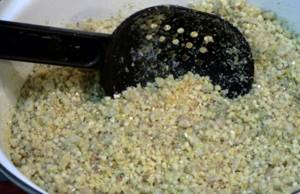
Mastyrka
It consists of two main components - whole dried yellow peas and semolina. It is possible to add various flavorings, but this is not necessary, since the mastyrka itself has a rather strong odor.
Prepare as follows:
- Pour 1 cup of peas into a saucepan, add water to 2 cm above and put on fire.
- After an hour, the peas will become soft and you need to mash them, then leave the lid open.
- When almost all the water has boiled away, add semolina to the pan and stir thoroughly.
- While stirring the porridge, evaporate the water, bringing the consistency to the desired state. The bait is ready.
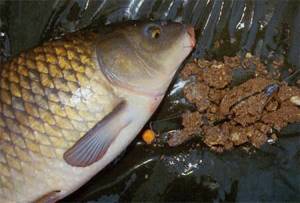
Hominy
There are several ways to prepare mamaliga. Let us describe a more straightforward method, which is in no way inferior to the others.
To prepare it, you need to do the following:
- Slowly pour 1 kilogram of corn flour into 1 liter of boiling water. Stirring constantly.
- After the mass has become homogeneous, the fire is turned off, but mixing continues.
- Once the resulting mass has cooled, you can roll it into balls, fill feeders, etc.
You can add flavorings: a little flavored sunflower oil, ground seeds, cake, honey, vanilla and others. It all depends only on the imagination of the fisherman and the personal preferences of the carp.
Fishing for carp in spring - tips
- When fishing on a feeder, it is better to take several rods with you.
- Carp is heat-loving - look for it in creeks and recesses, creeks, shallows where light penetrates more strongly, and in areas that warm up first.
- A fallen tree or snag is an excellent potential place for carp and carp.
- Carp spawning begins at 18 degrees, be careful, during spawning there is a ban on carp fishing.
- Carp loves muddy bottoms.
Thank you for reading our article, if you have any questions, ask them in the comments. No tail, no chishuya!
☸ Bait for carp
What to feed carp with? Until mid-spring, the best carp bait is considered to be sunflower cake mixed with soil with the addition of food bloodworms or crushed worms. In this case, the soil should be taken directly on the bank of the river or lake where fishing is carried out. Later, when the water temperature rises to the desired level and the carp switches to the summer feeding mode, any porridge with additional ingredients will be suitable to attract it. You should use fragrances with caution, as any strong odor can have the opposite effect.

Tackle
Spring carp fishing usually involves the use of a float rod and feeder tackle.
Float tackle
The float tackle is as follows:
- Carbon fiber telescopic rod, 5-6 meters long
- Inertia-free reel, size 2500-3000 with adjusted friction brake
- Mono line, diameter 0.22-0.24 mm or braided line, diameter 0.18-0.2 mm
- Float, inconspicuous color, weight from 1 to 3 grams
- Shot weights
- Hook 6-12 numbers depending on the bait
Feeder
The feeder tackle is as follows:
- Rod 3-4 meters long, weight up to 100 grams and up to 120 for heavier feeders
- Spinning reel, size 3500-4000
- Mono line, with a diameter of 0.26 mm or more, no braid is needed, since sensitivity is not so important
- Feeder depending on fishing conditions - frame, spring or flat
- Leashes, diameter 0.15-0.18 mm, length depending on the design of the tackle
- Hooks 6-10 numbers
Where can and where should you not fish in early spring?
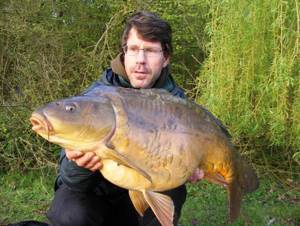
The effectiveness of carp fishing (specifically in early spring) depends on many factors, including cold cyclones (with characteristically high atmospheric pressure), and the alternation of warm days with cool (foggy) nights, and, of course, westerly winds (in Britain), blowing (coldly) from the North Sea. Therefore, a virtually impossible task (during carp fishing in early spring) is to get a bite from the bottom, especially in relatively/deep bodies of water (9 feet or more). Not only are large volumes of water in the deepest parts of the lakes not yet warmed up and have a strong influence on the overall temperature of the reservoir (by cooling smaller surface volumes), they are also distinguished by a higher density, which significantly reduces fish appetite.
Thus, taking into account the already reduced metabolism of carp (after a long winter), you should not even try to fish from the bottom! Most often, in early spring, fish will willingly feed - either in the middle or in the surface layers of water, maximally saturated with oxygen. In addition, for the simple reason that the middle, and especially the surface layers of the reservoir, begin to warm up from the sun in the spring, life begins there (that is, plankton and other living organisms “come to life” after winter, they are also delicacies for carp) .
So, the most effective results can be provided to you by fishing from the surface, where in relatively warm (and oxygenated) waters, the fish will be more active, and therefore well-fed. However, the best option is shallow areas of the reservoir, even better/warmed by the sun (than surface ones). Especially near the shores overgrown with reeds. Judging by the latest information (about the situation in reservoirs), an impressive number of successful carp bites in early spring were recorded at a depth of no more than 12 inches. It was near the reed thickets. And this is not surprising, because... reed is different in that, accumulating solar energy (for its own growth), it “gives” its heat into the water!
⚙ Useful advice
In the spring, you often come across trophy carp, and even with a belly full of delicious caviar. It is advisable to take pictures with these and release them back to their native element, because caviar is the future small carp, from which they can later grow into giants. It’s worth giving them this opportunity, and there will still be trophies. Let's not forget that in recent years, the fish stocks of our reservoirs have noticeably decreased, and in some of them nothing is caught at all.
